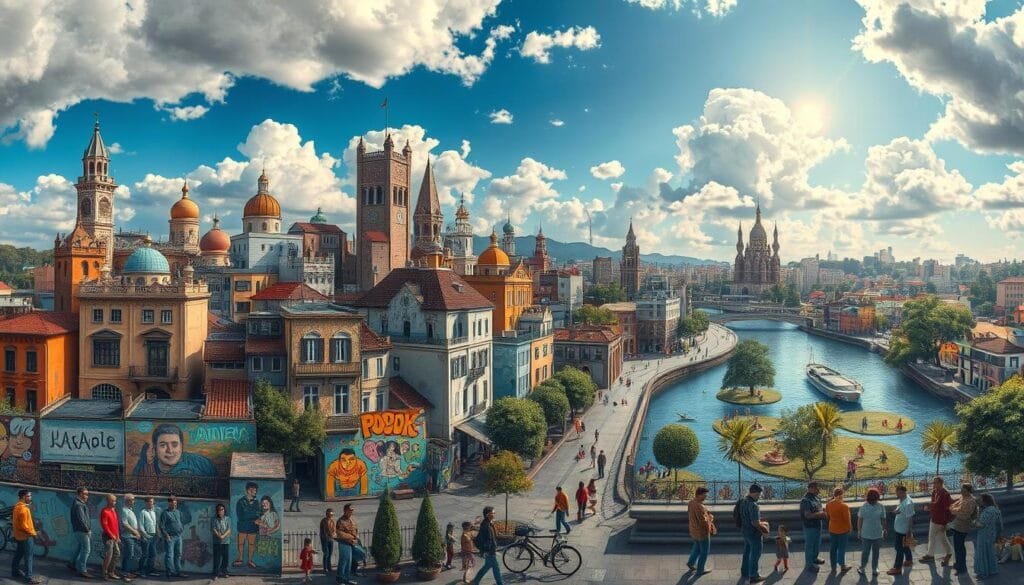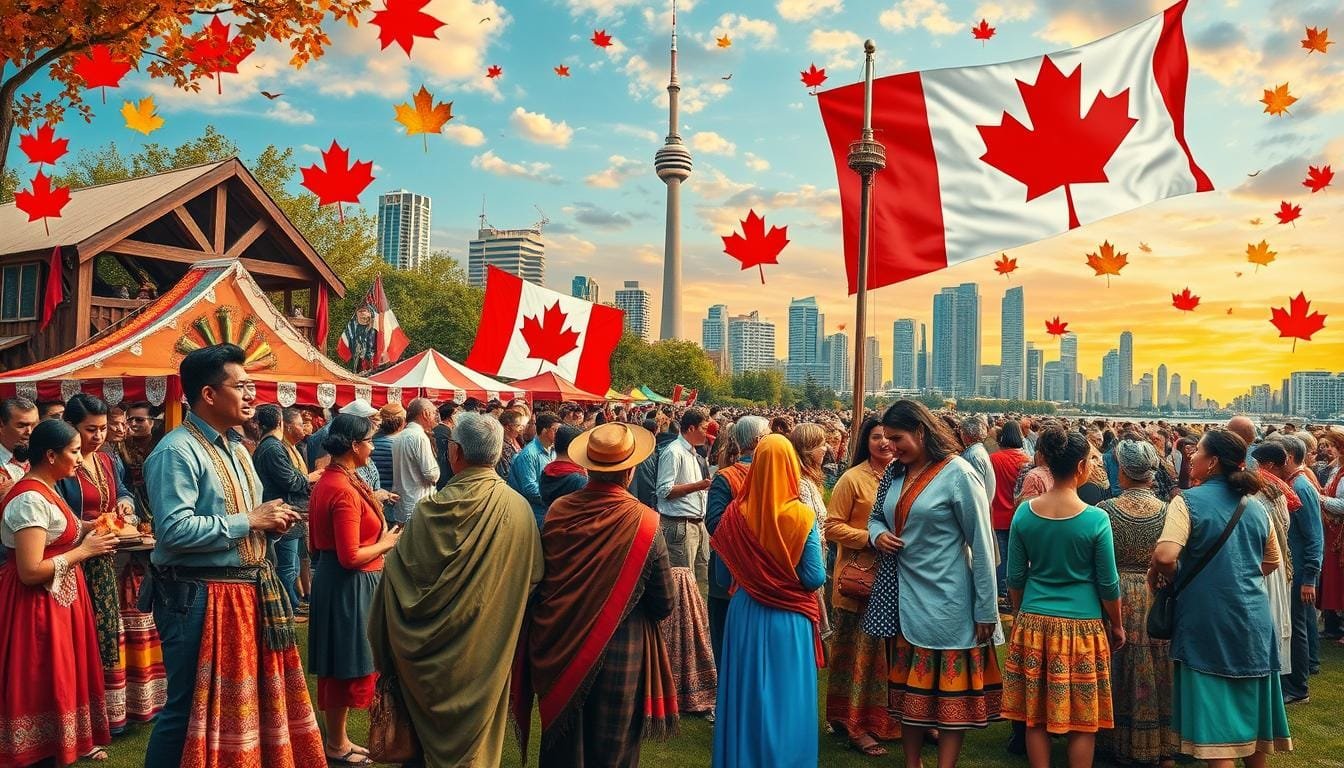Is Canada truly good at blending many cultures into its mosaic? This question is important because mixing cultures in Canada has many layers.
Canada is known for valuing cultural identities while pushing for everyone’s participation in society. But, reality often misses the mark. Negative stereotypes about Aboriginal peoples quickly catch on among new immigrants. Both these groups also face high joblessness.
In cities, about 800,000 Aboriginal people struggle with job market barriers, like new arrivals do. The Truth and Reconciliation Commission has pushed for more talks between Aboriginal communities and immigrants. Yet, integration is still a tough path.
Tim Van Horn’s 54,000 photos over eight years show Canada’s cultural diversity. But, does this diversity truly mean everyone is included equally?
Key Takeaways
- The Aboriginal population in Canada includes 4.3% of the total Canadian populace, with over 800,000 living in urban areas.
- New immigrants often adopt negative stereotypes about Aboriginal people shortly after arrival, underlining challenges in cultural understanding.
- High unemployment rates are observed both among Aboriginal groups and new immigrants.
- Canada’s policy of multiculturalism aims at cultural identity maintenance along with societal participation.
- Cultural enclaves might offer social support but can also hinder full integration into Canadian society.
- The concept of Canadian mosaic contrasts with the American melting pot, highlighting different approaches to cultural integration.
- The Truth and Reconciliation Commission has emphasized ongoing dialogue between Aboriginal peoples and new Canadians.
The Current Landscape of Immigration in Canada
Canada is known for welcoming immigrants. This is shown in the detailed Canada immigration statistics. By 2001, 5.4 million people born elsewhere made up 18.4% of all Canadians. This was the largest share since 1931. Most newcomers from the 1990s, 94% of 2.2 million, lived in major cities.
Statistics on Immigration
The Canada immigration statistics show how the country has changed. Only 64% of all Canadians, including new ones, live in big cities. Toronto, Vancouver, and Montreal attracted 73% of immigrants in the 1990s. One-third of immigrants seen in the 2001 Census came in that decade. From 1901 to 1911, immigrants made Canada’s population soar by 43%, with over 22% being from other countries.
Diversity and Inclusion Policies
Canada’s diversity policies show its aim for fairness. Despite changing immigration trends, Canada keeps improving its welcoming stance. The mix of people from the past shows how well these policies worked. It encouraged British and non-British people to make Canada their home. Today, the world praises Canada for how it blends different cultures together.
Barriers to Social Integration
Still, immigrants face social integration barriers. Studies find that recent arrivals sometimes struggle more in the economy. Those who come during hard times do not do as well as those who come when the economy is strong. Immigrants and students from other countries feel more lonely and isolated than those born in Canada. This shows we must keep working on our policies to help everyone fit in better.
Challenges Faced by Immigrants: Social Isolation and Loneliness
Immigrant loneliness in Canada is becoming a big issue. Many people move to a new place and face tough challenges. Studies point out that families, especially women and children from refugee backgrounds, feel very isolated.
Statistics on Loneliness Among Immigrants
Statistics Canada reveals that many newcomers feel out of place. About 65% of refugee women feel alone when they first arrive. Additionally, close to 70% find it hard to get help for mental health issues, making loneliness worse.
Even kids with immigrant parents feel lonely. They struggle with losing family and facing racism. This deeply affects their mental health.
Factors Contributing to Social Isolation
There are many reasons why immigrants feel left out in Canada. Trouble with language makes it hard to connect with others. Also, facing racism keeps them from feeling part of the community.
Not having enough community support and poor settlement services make things worse. Research shows that 78% of refugees feel services don’t meet their needs. They need better support to fight loneliness in Canada.
Immigrant coaches in Canadian sports face these cultural issues too. They struggle with communicating and finding social support. For more details, see the study about immigrant coaches and their challenges.
Importance of Ethnic Enclaves
Ethnic enclaves in Canada are crucial for immigrants, acting as a bridge between old and new worlds. They offer a safe space where newcomers can connect and find essential support.
Role in Providing Support Systems
Ethnic enclaves form a key part of immigrant communities, offering services in familiar languages and cultures. Places like Toronto’s Chinatown and Surrey’s Indo-Canadian community show how well this can work. They provide everything from groceries to cultural centers, tailored for their community’s needs.
Challenges within Ethnic Enclaves
Despite their benefits, ethnic enclaves face challenges with integration. They have high education levels but often suffer from high unemployment rates. This is partly because immigrants in these areas have limited social contacts outside their communities, as shown by Li Xue’s study. They also face economic hurdles, like lower incomes and home ownership difficulties, pushing them into lower-income neighborhoods.

Impact on Cultural Integration
Ethnic enclaves have a double-edged impact on cultural integration. They preserve cultural identities but can also slow broader community integration. Studies have found differences in how well immigrants in the same enclave integrate into Canadian society. This shows we need a balanced approach to integration that respects cultural uniqueness.
This data shows the diversity in Canada and the role of these communities:
| Statistics | Data |
|---|---|
| Visible Minorities (2006) | 16.2% |
| First or Second-Generation Immigrants | 41% |
| Foreign-Born Canadians | 1 out of 5 |
| Number of Immigrants in 2008 | 247,243 |
| Percentage of World’s Refugees Resettled by Canada | Over 10% |
| Top Immigrant Source Countries (2012) | China, Philippines, India |
| Ethnic Groups with 100,000+ Members (2006) | 34 |
| Ethnic Groups with 1,000,000+ Members | 11 |
Ethnic enclaves truly reflect Canada’s rich multicultural landscape, showing the strengths and struggles of cultural integration.
Government Initiatives and Support Structures
Canada uses federal, provincial, and city efforts to help immigrants fit in and do well. These efforts focus on helping newcomers become part of the community, valuing integration. They respect each person’s background while helping them blend into Canada’s diverse culture.

Current Policies and Programs
The Canadian multiculturalism program is run by Canadian Heritage. It offers important services like learning English or French. The 1988 Canadian Multiculturalism Act celebrates Canada’s diversity. It recognizes diversity in race, origin, color, and religion as key.
Immigration rules change as the population does. Most immigrants live in big cities like Toronto, Vancouver, and Montreal. These cities have special plans to welcome newcomers. They support diversity and help newcomers feel like they belong.
Gaps and Opportunities for Improvement
Even though many policies work well, there are still areas to improve. Cities with many immigrants, like Brampton, need more money for community and infrastructure. This lack of funds makes it hard to provide good healthcare and social services.
Also, even though Canadian Heritage doesn’t fund heritage culture upkeep, there’s a big need. More support for keeping cultures alive and helping immigrants fit in would make a difference. Improving these areas could make it easier for immigrants to feel at home in Canada.
| Municipality | Integration Efforts | Challenges |
|---|---|---|
| Toronto | Extensive multicultural policies, strong support structures | High demand on healthcare and housing resources |
| Brampton | Moderate integration programs | Significant resource strain, particularly in healthcare and community services |
| Vancouver | Comprehensive support programs, diverse cultural initiatives | Affordable housing issues |
| Surrey | Strong community networks and multicultural initiatives | Infrastructure needs enhancement |
Looking at Canada’s immigration policies and gaps helps us see what needs more support. Better government support can help immigrants become a vibrant part of Canada’s community.
Does Canada Have a Hard Time Merging Cultures in Its Canadian Mosaic?
Canada is known for its “Canadian Mosaic,” a multicultural ethos. This was started with the Multiculturalism Act of 1988. It shows how cultural diversity is a key part of the nation’s identity. Yet, merging cultures in Canada is more complex than it seems.

One big challenge is balancing cultural heritage with becoming part of wider Canadian society. The main languages, English and French, set a scene. Immigrants balance their identities within this. In Quebec, the Charter of the French Language pushes French integration, making it hard for non-French speakers.
Racism and xenophobia also make merging tough. Data from Statistics Canada shows minorities often face more joblessness and lower pay. Around 60% of racialized Canadians feel discriminated against. This makes social joining harder and unfair.
Indigenous groups also face historical sidelining. The Truth and Reconciliation Commission found many feel past wrongs are still not fixed. This makes their integration into the mosaic tough.
Education disparities show more challenges. Students from racialized backgrounds face more suspensions. This hurts cultural understanding across regions.
As demographics change, initiatives on cultural awareness lag in some regions. In Quebec, most people see themselves as Québécois over Canadian. This shows a strong provincial identity.
To overcome these hurdles, we must review and change our policies. We should aim for a harmonious cultural merging in Canada. Making the Canadian mosaic a reality is an ongoing effort.
| Statistic | Insight |
|---|---|
| Visible Minority Unemployment Rates | 2-3 times higher than Canadian-born counterparts |
| Racial Minority Wage Gap | 25% less on average than white Canadians |
| Historical Marginalization | 80% of Indigenous communities feel injustices are unaddressed |
| Language Dominance | Bill 101 reinforces French dominance in Quebec |
| Educational Disparities | Higher suspension and expulsion rates for racialized students |
Asset-Based Community Development (ABCD) as a Solution
When we look into immigrant community integration, ABCD stands out. It takes a strengths-based approach. It looks at what a community already has and uses that to grow. This way, ABCD builds on the good things in a community, making people rely on themselves more. It has worked around the world, helping immigrant communities get stronger together.
Principles of ABCD
ABCD works because it sticks to key ideas:
- Asset Mapping: This means finding all the good stuff a community has, like people’s skills or local groups.
- Inclusion and Participation: It makes sure everyone in the community helps make decisions. This increases their commitment and accountability.
- Relationship Building: It’s about connecting people in the community. They help each other and work together better.
- Sustainable Development: ABCD looks for ways to grow using what the community already has. This ensures long-term success.
By following these principles, communities feel safer and more united. For example, places like Mosul have rebuilt important stuff by working together, thanks to ABCD.
Application of ABCD in Immigrant Communities
ABCD can really help immigrant communities come together. It uses what the community has to solve problems. In Iraq, ABCD helped youth and women become more empowered. This made their communities better.
In southern Iraq, ABCD was used to help the environment and bring people closer. Jaideep Johar’s work in Canada, like helping the Winnipeg Public Library Board, shows ABCD in action. He promotes safety and diversity.
Organizations like the Global Citizen movement and the David Suzuki Foundation have worked with Johar. They help with things like Harvest Manitoba and Beds for Children. These efforts show that using what a community has can do a lot of good. It helps immigrant communities feel like they belong and can make a difference.
Experiences of International Students
International students in Canada face both rewards and challenges. The rise in international students brings unique challenges. It’s crucial to address these issues.
Adapting to Cultural Differences
The country’s multiculturalism policy since 1971 helps. Yet, adapting to cultural differences can be tough. At first, unfamiliar traditions may feel isolating.
Engaging in local and campus activities helps bridge cultural gaps. This encouragement creates a welcoming environment for all.
Tackling Language Barriers
Language barriers are a big challenge for these students. While English or French skills are needed, levels vary widely. Support programs and language groups aid in overcoming these obstacles.
These efforts build confidence and ease communication fears. They help students join in more activities and feel part of the community.
Building Social Connections
Forming social connections can be very hard. Even with Canada’s appeal, making friends is not always easy. Economic, educational, and cultural differences widen the social gap.
Thankfully, programs exist to help bridge this divide. Pairing with local mentors and joining interest groups can foster friendships.
Universities are now offering more tailored support. They focus on resources and programs that aid both academically and socially. This shows a commitment to international student success.
For more on these social challenges, check our full analysis here.
Conclusion
As we wrap up our look into Canada’s journey of cultural integration, we see its complexity and continuous nature. Canada was a pioneer in 1971 when Prime Minister Pierre Elliott Trudeau recognized multiculturalism. This was a big step in accepting diversity, moving beyond just two cultures.
This shift did not just meet the cultural needs then. It also started building a more welcoming society. Through this, the government introduced programs to help immigrants and different ethnic groups blend in.
Looking at Canada’s cultural meld, we see significant strides have been made. Key milestones include the Royal Commission on Bilingualism and Biculturalism and protections added in the 1982 Constitution and the 1988 Multiculturalism Act. These steps have deeply influenced Canada’s national identity.
The mix of Indigenous people, European settlers, and later, immigrants from many corners of the world has enriched Canada’s culture. This blend has strengthened Canada’s promise to value multiple ethnicities.
But, the work isn’t done; Canada still faces challenges and debates. Its unique “cultural mosaic” approach, different from the “melting pot,” needs ongoing effort. This includes making policies that embrace diversity, community understanding, and active involvement from everyone.
The dream of a united, inclusive Canada depends on tackling issues like social isolation. It involves smart use of ethnic neighborhoods and methods like Asset-Based Community Development (ABCD). By working together towards peace, orderly governance, and inclusivity, Canada continues to showcase its ever-evolving identity.
FAQ
What are the main challenges in cultural integration in Canada?
In Canada, cultural integration faces several challenges. These include overcoming language barriers and addressing racial discrimination. They also involve fostering social connections and ensuring fair access to resources for diverse communities.
What does the term ‘Canadian mosaic’ refer to?
The term ‘Canadian mosaic’ describes Canada’s approach to national identity. It celebrates multiculturalism, allowing different cultures to live together. Each culture adds to the overall culture of Canada.
How significant is Canada’s immigrant population?
Canada is eighth worldwide in its number of foreign-born residents. This shows its strong immigrant population and dedication to welcoming immigrants.
What policies support diversity and inclusion in Canada?
Canada has various policies to support diversity and inclusion. These include the Multiculturalism Act, settlement services, and laws against discrimination. They aim for a society that is fair, diverse, and inclusive.
What barriers do immigrants face in social integration?
Immigrants face many barriers in fitting into society. These barriers include challenges with language, facing racial discrimination, and the lack of community support. All these can make them feel lonely and isolated.
What statistics highlight loneliness among immigrants in Canada?
Statistics from Canada show that immigrants and international students feel much lonelier and more isolated than people born in Canada.
What factors contribute to social isolation among immigrants?
Language barriers, a lack of community support, and racial discrimination contribute to immigrants feeling isolated.
How do ethnic enclaves support immigrants in Canada?
Ethnic enclaves help immigrants by offering a sense of community. They share the same ethnicity, culture, and language. This helps immigrants adjust better to their new surroundings.
What challenges exist within ethnic enclaves in Canada?
Within ethnic enclaves, there are several issues. There’s limited access to socio-economic resources and issues related to over-policing. There are also challenges in connecting with the wider Canadian society.
What government initiatives support immigrant integration in Canada?
The government has many programs to help immigrants fit in. These include language training, help finding jobs, and projects to build community. These are run at the federal, provincial, and local levels.
Are there gaps in the current support structures for immigrants?
Yes, there are gaps in support for immigrants. There’s not enough money for community places and limited healthcare in areas with many immigrants. These issues put pressure on immigrant communities.
Does Canada find it difficult to merge cultures into its Canadian mosaic?
Merging cultures into the Canadian mosaic faces difficulties. These include racial prejudices and xenophobia. There’s also the challenge of keeping cultural heritage while fitting into Canadian society.
What is Asset-Based Community Development (ABCD)?
ABCD is about building community using what’s already there. It uses community’s own strengths to help immigrants fit in better and strengthen social networks.
How can ABCD be applied in immigrant communities?
ABCD works in immigrant communities by using their strengths. This includes local leaders, cultural richness, and safe neighborhoods. It helps immigrants feel they belong and empowers them.
What challenges do international students face when adapting to Canadian culture?
International students have their own challenges. They struggle with language barriers, adapting to a new way of life, and becoming part of campus and local communities.
How can international students overcome language barriers in Canada?
International students can beat language barriers through language programs, practice talks, and joining campus language groups. This helps them improve their language skills.
What strategies can help international students build social connections in Canada?
To make friends, international students can join campus clubs, go to cultural events, and volunteer. These activities help them meet people and build networks.
